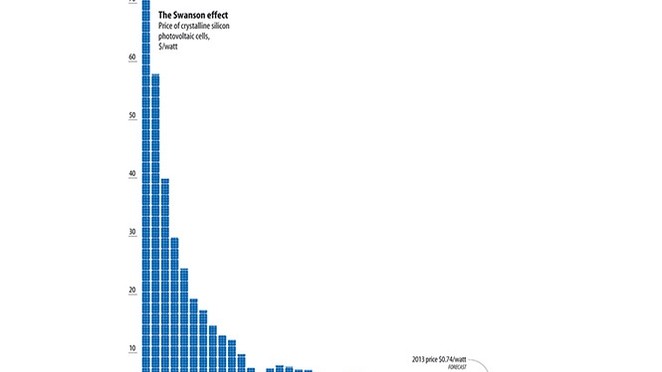Spot prices for solar modules around the world hit 63 cents per watt in 2014’s second quarter — an all-time low.
Spot prices are the cost of any good or service at any given time and place. (In this case, the aggregate world spot price in Q2.) The numbers come via the research arm of GreenTech Media, and while spot prices can’t encompass all market trends — a majority of solar modules are bought and sold via bilateral contracts rather than immediate market transactions — they do fall in with the ongoing collapse of solar module prices over the last few decades.
The modules are a packaged collection of solar cells, and the basic unit out of which any solar photovoltaic array is constructed. GreenTech Media attributes the new low for spot prices to several factors. First, the price of the wafers and solar cells that make up the modules dropped from 2014?s first quarter, thanks especially to an unusually large fall in the price of their building materials — mainly polysilicon. There was also a slight drop in module price for the some of the traditionally more expensive markets, such as Japan’s utility-scale sector. And finally, demand for modules in major markets like China dipped a bit, while sales in the lower-priced regions like Latin America increased.
The overall result was a dip in the spot price from a 70-cents-per-watt high about this time last year:
“The fall in spot price in the first half of 2014 is not like previous years,” said GreenTech Media Solar Analyst Jade Jones. That was when a glut of supply produced more modules than the global markets were demanding. This time “high [average selling price] regions (U.S., U.K. and Japan) provided steady demand. The downward trend in prices is likely reflective of seasonally weak prices in low [average selling price] regions (China), large volumes of lower-priced, off-spec modules (i.e., modules with lower wattages than the industry standards), and lower-tier suppliers in regions such as Malaysia and Vietnam offering aggressive prices to gain market traction.”
The trend can also be seen in America specifically, where solar installations continue a brisk rise. The manufacturing costs of solar panels in the U.S. have arguably dropped 60 to 70 percent in recent years, and installation costs are dropping alongside them. In fact, the price of solar has gotten so low it’s beginning to outbid traditional fossil fuels in utility deals that are required to seek the least expensive option under federal law.
Internationally, the dropping cost of the modules is translating into lower costs fore the electricity generated by solar power. It’s already pulled even with the price of conventional electricity in Italy and Germany, and the economics of solar are now good enough that China’s gearing up for a truly massive 1,000 megawatt solar plant complex in the desert.
GreenTech media did warn that some of the trends that led to the latest spot price drop may be ephemeral. The cost of materials like polysilicon and silver are expected to rise back up later this year, which will force major manufacturers to find other ways to keep cutting costs. Firms in China, for example, got to the current low by relying on technological advancements and economies of scale along with the drop in polysilicon expenses.
“A popular strategy in recent times is the adoption of increased manufacturing automation in China due to steeply rising labor rates,” said Shyam Mehta, GreenTech Media Research’s Lead Upstream Solar Analyst. “Particularly in the areas of cell inspection, testing, stringing and tabbing, where using machines in place of human beings not only saves labor costs but can also drive improved manufacturing yields and more consistent product quality.”
By Jeff Spross



